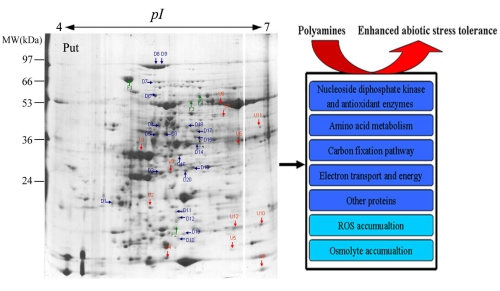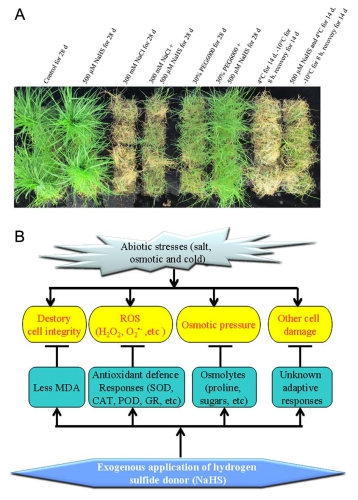The Protective Roles of Exogenous Polyamines and H2S in Response to Abiotic Stress Revealed
2013-09-03
Abiotic stress including salt, osmotic and cold stresses drastically affect plant growth and limit crop production worldwide. As sessile organisms, plants have developed many molecular and biochemical adaptive mechanisms to advent stress triggered damage, such as the induction of important messengers including hydrogen peroxide (H2O2), hydrogen sul?de (H2S)and polyamines. Bermudagrass (Cynodon dactylon) is a warm-season turfgrass, and widely used on home lawns, golf courses and sport fields. Bermudagrass is adapted to cultivation in a range of climate conditions, but the signaling pathways of bermudagrass in response to abiotic stress were largely unknown.
Dr. SHI Haitao under the supervision of Prof. CHAN Zhulong from Key Laboratory of Plant Germplasm Enhancement and Specialty Agriculture, Wuhan Botanical Garden performed comparative proteomic and physiological analysis to reveal the protective mechanism of exogenous polyamines and H2S in response to abiotic stress.
The pre-treatment of exogenous polyamine conferred increased salt and drought tolerances in bermudagrass. Comparative proteomic analysis identified 36 commonly regulated proteins by at least two types of polyamines in bermudagrass. Among them, proteins involved in electron transport and energy pathways were largely enriched, and nucleoside diphosphate kinase (NDPK) and three antioxidant enzymes were extensively regulated by polyamines. Dissection of reactive oxygen species (ROS) levels indicated that polyamine-derived H2O2 production might play dual roles under abiotic stress conditions. Moreover, accumulation of osmolytes was also observed after application of exogenous polyamines, which was consistent with proteomics results that several proteins involved in carbon fixation pathway were mediated commonly by polyamines pre-treatment. Taken together, the researchers proposed that polyamines could activate multiple pathways that enhance bermudagrass adaption to salt and drought stresses.
The researchers also applied exogenous H2S donor (NaHS) on bermudagrass to investigate the in vivo role of H2S to salt, osmotic and cold stresses. All these data indicated the protective roles of H2S in bermudagrass responsed to salt, osmotic and freezing stresses, via activation of the antioxidant response and osmolyte accumulation. These ?ndings might be applicable to grass and crop engineering to improve abiotic stress tolerance.
Relevant results were published in “Journal of Proteome Research(doi: 10.1021/pr400479k)”and “Plant Physiology and Biochemistry(doi: 10.1016/j.plaphy.2013.07.021)”.

Comparative proteomic and physiological analysis of the protective mechanism of exogenous polyamines in response to abiotic stress (Image by Dr. SHI Haitao)

Exogenous application of H2S donor enhanced abiotic stress tolerance in bermudagrass (A), and a proposed model for H2S-mediated abiotic stress responses in bermudagrass(B). (Image by Dr. SHI Haitao)